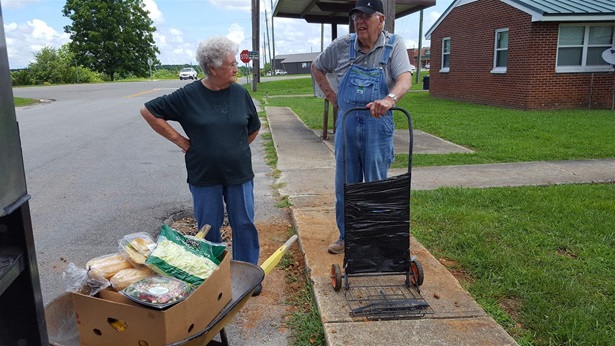Thursday, March 21, 2024
Family caregiving can be isolating and lonely. A support group can help. But which one? March 21, 2024
Thursday, April 13, 2023
Voting to raise their own pay puts state lawmakers in a bind -- on Stateline 13 April 2023
Source https://www.pewtrusts.org/en/research-and-analysis/blogs/stateline/2023/04/13/voting-to-raise-their-own-pay-puts-state-lawmakers-in-a-bind
Voting to Raise Their Own Pay Puts State Lawmakers in a Bind
“Could a single parent be a state rep? Absolutely not. If you are the sole wage earner in a family, you can’t afford it — or even if you’re the primary wage earner,” Louisiana state Rep. Joe Marino said in an interview with Stateline.
The salary for a Louisiana state lawmaker is $16,800 a year — unchanged since 1980. Marino, an Independent, introduced a bill in March that would hike legislators’ salaries to $60,000 a year — $4,600 less than what $16,800 would be in today’s dollars.
Unless salaries are raised, he said, “We’ll have a legislature of only wealthy or retired people.”
State legislative salaries range widely. In New York, lawmakers gave themselves a 29% raise to $142,000 annually as of January, making the legislature the highest paid in the country. At the other end of the spectrum, New Mexico legislators receive no salary. Many states also pay a per diem rate during sessions, which may be taxable as income, and mileage.
New Mexico lawmakers receive per diem and mileage, so they’re not the lowest paid in the country; that distinction goes to New Hampshire, which pays legislators $100 a year with no per diem. New Hampshire’s nominal salary has been in the state constitution since 1889, and New Mexico’s unpaid legislature dates to the constitution adopted with statehood in 1912.
Efforts this year in both legislatures to put the question of salaries to voters failed.
Resistance to higher state legislative salaries is purposeful and historic. New Hampshire and New Mexico are among states that prize a “citizen legislature” — people from different walks of life who meet at the state capitol for a few weeks or months and go back to their regular jobs — rather than professional politicians who make a career of legislating.
Smaller and more rural states tend to have part-time legislatures, pay legislators less and have smaller legislative staffs, while the largest states usually have full-time legislatures, pay the most and have large legislative staffs, according to the National Conference of State Legislatures.
But lawmakers face a heavier workload and greater demands on their time beyond state legislative sessions than they used to, legislators and scholars say.
“It’s not a part-time job. It’s not a full-time job. It’s a full-time-plus job, a fully encompassing job,” New Hampshire state Rep. Walt Stapleton, a Republican in his third term, told Stateline.
Stapleton this year introduced a resolution to put a constitutional amendment on the ballot that would raise pay to $2,500 a year or $5,000 for the biennium. In today’s dollars, that $2,500 is worth less than $100 in 1889, but his measure failed.
“It’s surprising that you can get people to sacrifice a lot in their private life and personal finances to run for state legislatures,” said Peverill Squire, a political scientist at the University of Missouri who has studied state legislatures for decades.
“The idea has long been that legislative service should be seen as public service. That’s easy to say when it’s not your paycheck,” he said.
States use three approaches to set legislators’ compensation, according to NCSL. As of last year, 19 states either set salaries by law or refer ballot initiatives on pay to voters. With this hands-on approach, legislators face what the conference calls the “pay problem,” that is, lawmakers risk a political firestorm if they raise their own salaries.
“Legislators are hesitant to raise pay because of the optics around it,” Josalyn Williams, policy associate at the conference’s Center for Legislative Strengthening, told Stateline.
In 21 states, independent commissions recommend salaries, insulating the legislature from criticism. For example, Minnesota lawmakers will receive a 7.25% pay increase in July, from $48,250 to $51,750 a year, as set by the state’s Legislative Salary Council. Voters in 2016 approved a constitutional amendment authorizing the council. Previously, legislators set their own pay, which had remained at $31,140 from 1999 until the council started determining salaries in 2017.
Ten states and Washington, D.C., link pay to an outside factor — such as median household income or the inflation rate.
Alabama voters, for example, approved a constitutional amendment in 2012 tying legislators’ pay to the median of the state household income. The salary in 2022 was $53,956.
Legislators in at least eight other states this year considered or are considering bills related to legislative compensation — Alaska, Kansas, Maine, North Carolina, Oregon, Vermont, Virginia and West Virginia.
A newly appointed commission recommended Alaska legislators receive a 67% raise to $84,000 a year. Legislators tried to cancel the increase, but Gov. Mike Dunleavy, a Republican, vetoed it, so the raise is expected to take effect Jan. 1, barring further developments.
After Georgia legislators failed to pass bills raising their pay, Gov. Brian Kemp, a Republican, last year proposed in his budget and lawmakers approved a $5,000 cost-of-living raise for state legislators and all state employees, giving lawmakers their first increase since 2007 — to $22,342.
Voters around the country have punished legislators who raised their own pay.
When Pennsylvania lawmakers voted at 2 a.m. July 7, 2005, to raise their pay as well as that of other elected officials, it ignited a grassroots movement to defeat incumbents. The pay raise was rescinded a few months later, but dozens of legislators retired or lost their seats in the next primary and general elections.
Pennsylvania lawmakers received a 7.8% cost of living adjustment Dec. 1, raising salaries of rank-and-file legislators to $102,844. Half a dozen Pennsylvania legislators refused to take a pay increase this session.
Legislators in Texas make $7,200 a year in salary as well as a per diem of $221 a day and mileage. The Texas legislature meets in regular session every two years for up to 140 days, and the governor can call special sessions of 30 days as needed.
“There are a lot of challenges to the lack of a living wage for legislators,” Arturo Vargas, executive director of the National Association of Latino Elected and Appointed Officials, said in an interview. “It limits the ability of those who are the average citizen from serving in office. It’s a minority of the workforce that can set their own work schedule.”
Most people don’t know who their state legislator is, whether the legislature is full or part time or what the compensation is, surveys show. Salaries are far lower than most people think. Asked how much their legislators are paid, 66% of New Mexico residents guessed $35,000 or more, a Common Cause New Mexico survey last year found.
New Mexico state Rep. Angelica Rubio, a Democrat, this year sponsored the bill for a ballot initiative that would have asked voters for the authority to establish a commission on legislative compensation. A majority of Democrats, Republicans and independents in the Common Cause survey favored having an impartial commission set legislators’ salaries. Rubio’s bill passed in the House with only Democratic support and died in the Senate.
“People in the legislature who oppose salaries have a romanticized notion of the citizen legislature,” Rubio said in an interview with Stateline. “They have outside income and can afford to serve without pay.”
A community organizer whose consulting business works with nonprofits on housing and other social issues, Rubio tries to recruit legislative candidates, but, she said, the path to the legislature “is closed off to the people I work with. When people find out there’s no pay, they say no.”
Even with per diem and mileage allotments, serving in the legislature without a salary can be financially challenging.
“I have to save throughout the year to be able to live in Santa Fe for two months — and I come back in the red,” said Rubio, 43.
In Louisiana, Marino, an attorney in private practice and former Gretna city council member, has been elected twice to the legislature without facing any opposition.
“The pool of people who are able to run keeps shrinking,” he said. “What job do you have where you can be gone from three to six months and with only a week’s notice be called back” into special session? “No job.”
If his proposed pay raise succeeds, Marino won’t benefit. He is not running for reelection, saying low pay and wanting to spend more time with his family are factors in his decision.
“I’m trying to make a difference, but that doesn’t pay the mortgage,” he said.
Tuesday, February 28, 2023
States Strive to Help SNAP Recipients Cope With Lower Benefits -- on Stateline.org Feb. 28, 2023
States
Strive to Help SNAP Recipients Cope With Lower Benefits
STATELINE ARTICLE February 28, 2023
By: Marsha Mercer
Allison Dinner The Associated Press
The white words on a
red background are plain. “Important notice: SNAP emergency allotments ending
after February.”
If there’s any doubt,
the Colorado Department of Human Services SNAP webpage adds, “All Coloradans
who receive SNAP benefits are going to see a reduction in their monthly benefit
amount after February.”
In every state,
participants in the Supplemental Nutrition Assistance Program, commonly known
as food stamps, face the loss of pandemic-related benefits in March, if they
haven’t already lost them. States, community groups and food banks are
scrambling to help families cope and gear up for an expected wave of food
hardship.
“People are scared.
They’re anxious. This is a devastating change,” Karla Maraccini, director of
the Food and Energy Assistance Division of the Colorado Department of Human
Services, told Stateline. “We want to make sure nobody is caught
off guard in March.”
Colorado has a new,
toll-free SNAP phone line and its SNAP website includes tips for the transition
and a Food Finder link to locate the closest food pantry.
The average SNAP
participant in states that still had emergency allotments as of February will receive
$90 less a month in benefits, according to an analysis by the Center on Budget
and Policy Priorities, a left-leaning think tank.
“We’re saying these
families face a hunger cliff — more hardship and more food insecurity. People
don’t have a cushion,” Ellen Vollinger, SNAP director for the Food Research and
Action Center, an anti-hunger advocacy group, told Stateline.
In March 2020, as
COVID-19 swept the nation and the economy shut down, Congress gave states the
authority to ease application and eligibility requirements for SNAP and to hike
benefits with temporary emergency allotments.
The allotments were
expected to last for the duration of the federal public health emergency in
states that also had declared a public health emergency. But Congress in
December passed a bipartisan federal spending package that ended SNAP
allotments as of February 2023.
By the end of last
year, 17 states had dropped state public health emergency status, meaning SNAP
recipients in those states no longer received extra benefits.
The end of the federal
public health emergency, recently set for May 11, will trigger other changes in
SNAP that lower some benefits. Plus, Republicans in Congress are eyeing SNAP
for potential cuts in the debt limit debate. The federal government pays for
all SNAP benefits.
The spending package
that ended the allotments early also established a permanent Summer Electronic
Benefit Transfer for Children food service program. Families eligible for free
or reduced-price school lunches will receive a monthly $40 grocery benefit per
child when school is out starting in 2024.
The Summer EBT program
is “the most significant new nationwide nutrition program in the last 50
years,” according to Vince Hall, chief government relations officer at Feeding
America, the nation’s largest domestic anti-hunger network. But, he said, “as
critical as it is, it is not a replacement for solving the nutritional needs of
the whole family.”
STATELINE STORY February 13, 2023
States Scramble to
Replace Ripped-Off SNAP Benefits
More than 41 million
people purchased food with SNAP benefits last year, up from about 36 million in
2019, and the emergency allotments represented a huge inflow of federal funds
to states.
In recent months,
nearly $3 billion a month in additional benefits went to the states where the
allotments were still in effect, according to the Center on Budget and Policy
Priorities.
“I’m not aware of any
state trying to replace the emergency allotments,” said Ed Bolen, director of
SNAP State Strategies at the center.
The end of the
allotments comes as state legislatures are in session and legislators are
writing budgets for the next fiscal year, and a few states are taking steps to
lessen the impact of lower benefits. But so far, New Jersey is the only state
this year to enact SNAP legislation, according to the National Conference of
State Legislatures.
The Garden State has
twice raised the monthly minimum SNAP benefit — to $50 last year and to $95
this year. In most states, the regular monthly minimum SNAP benefit is $23
— and that’s after increases in 2021 and 2022.
The new minimum
benefit in New Jersey mostly will help older people and those with
disabilities, whose incomes have risen due to cost-of-living increases in
Social Security, said Carlos Rodriguez, president and CEO of the Community Food
Bank of New Jersey. A higher income leads to a decrease in SNAP benefits.
His organization,
which distributed food for more than 86 million meals last year, is preparing
for increased demand by buying more food at higher costs because of inflation.
A household survey in
December by Propel, a company that makes software SNAP recipients use to track
their benefits and other financial products, found that 30% of respondents
visited a food pantry in the last 30 days in states where emergency allotments
were no longer being issued, compared with 22% of respondents in states still
issuing emergency allotments.
In 2023 so far,
lawmakers in 27 states and the District of Columbia have introduced at least
131 bills to strengthen SNAP by expanding access to the program, decreasing
food and nutrition-related costs and providing emergency food aid, according to
the conference of state legislatures.
A bill introduced Feb.
15 in California would establish a $50 state minimum benefit in the CalFresh
program by January 2025. CalFresh is California’s SNAP program.
Last year,
Maryland raised the minimum monthly SNAP benefit to $40 for those 62 and older.
It was one of a dozen states that enacted 24 laws aimed at expanding or
enhancing SNAP, according to the conference of state legislatures.
More States Are
Forgoing Extra Federal Food Aid
In January,
Massachusetts Democratic Gov. Maura Healey proposed spending $130 million to
provide a bridge for more than 630,000 Massachusetts families, who would
receive a supplemental allotment equal to 40% of the federal benefit for three
months.
The array of state and
federal safety-net programs, often with different eligibility rules, can be
bewildering, so states are urging people to seek help determining the benefits
for which they qualify.
North Carolina, for
example, is encouraging pregnant women and mothers to sign up for the Women,
Infants and Children food program. In addition, the statewide NCCare360 network
is available to connect North Carolinians to health care, employment, housing
and social services.
“We know even though
the emergency allotments are coming to an end, the need is still there,” said
Madhu Vulimiri, deputy director of the Division of Child and Family Well-Being
in the North Carolina Department of Health and Human Services, which oversees
the SNAP program.
The bottom line:
“People will have less money to spend at the grocery store,” said Effie Rorke,
senior director of public policy and communications at Feeding Colorado, the
state association for Colorado’s five food banks, adding the need for food
remained high throughout the pandemic.
“We serve a lot of
people who are working or don’t get enough hours. Often food is the only item
where they have a little wiggle room,” she said.
The Food Bank of the
Rockies’ 800 members serve about half a million people a year over a wide swath
of Colorado and all of Wyoming.
“We’re not fully
meeting the need now,” said Erin Pulling, president and CEO of the Food Bank of
the Rockies. She and her partners are ramping up food purchases, donations and
fundraising and lobbying the state for more resources.
Thinking of the end of
the allotments, Princess Mack, 53, of Aurora, Colorado, who shops with SNAP
benefits for herself and two teenage daughters, said, “Does it make me nervous?
It does.”
Before the extra
benefits, she regularly visited a food pantry — something she hasn’t needed to
do in years. But she’s prepared to go back.
“I’m not as panicky as
some,” she said.
Tuesday, February 7, 2023
States Strive to Reverse Shortage of Paramedics, EMTs -- on STATELINE, Feb. 6, 2023
States Strive to Reverse Shortage of Paramedics, EMTs
Note: This story was updated, February 6, 2023, to clarify the capabilities of emergency medical responders who have completed the first level of training in Louisiana’s Jump Start program.
Low wages, a lack of work-life balance and burnout are among factors driving emergency medical services personnel around the country to quit ambulance duty.
Last year, the turnover rate for full-time emergency medical technicians, known as EMTs, was 36% and for full-time paramedics, it was 27%, according to an American Ambulance Association survey. The turnover rate includes both resignations and firings, but nearly all of the EMTs and paramedics who left did so voluntarily. More than one-third of new hires don’t last through their first year, the survey found.
A federal study projected a need for 40,000 more full-time emergency medical personnel from 2016 to 2030.
“The public doesn’t see where there’s no one in the station, and volunteer services are trying to muster a crew,” said Dia Gainor, executive director of the National Association of State EMS Officials and former director of the Idaho EMS office for 19 years.
When people call 911 to report a crisis — be it a car crash, drowning, shooting, difficulty breathing, heart attack, fall, stroke or drug overdose — emergency medical clinicians often are first on the scene to treat and transport the patient to the hospital. Agencies also transfer patients between hospitals.
To stave off longer 911 call wait times and the closure of ambulance services, many states are rethinking how they recruit and retain both paid and volunteer EMS workers. Nearly 40 state legislatures and Washington, D.C., considered bills in 2022 related to various aspects of emergency medical services, according to the National Conference of State Legislatures.
One idea is to expand the EMS workforce pool by age. As states felt the workforce pinch and began looking for younger clinicians, the National Registry of Emergency Medical Technicians, which tests and certifies EMTs, in 2019 eliminated any age requirement for certification. It had been 18.
At least six states have lowered the minimum age for EMT training to 16 or 17, according to NCSL. New Jersey, for example, allows 16-year-olds to enroll in training with parental consent. Indiana passed a law last year to allow retired emergency service personnel and some students to qualify for temporary licenses.
Louisiana is among states that offer EMS training classes in high schools. The Jump Start program started in 2015 and, by 2019, had led to the state licensing of 2,000 emergency medical responders, who have completed the first level of training and can provide immediate life-saving care until EMTs arrive on the scene. The program has also trained dozens of licensed EMTs, who can drive and care for patients in the ambulance, according to a report by the Louisiana Bureau of EMS.
“I’ve always liked medical stuff,” said Trentin Monk of Elizabeth, Louisiana, 16, who said his dream job is to become a flight paramedic, or a paramedic who works in an air ambulance. Last year at age 15 and as a sophomore in high school, he became the youngest certified EMT ever in Louisiana.
After Monk was certified nationally and had two rides in the ambulance, though, the fire department said he was too young to ride because of insurance rules. He volunteered for a few months longer but quit when he got tired of sitting around and not going on calls. He’s still glad he took the classes and the exam.
“It’s a good thing to put on my resume,” he said, adding he plans to return to EMT duties when he turns 18.
Most metropolitan EMS agencies in Louisiana choose not to hire employees under the age of 21 for insurance purposes, but many rural EMS agencies and fire departments will hire people over the age of 18, according to the state EMS report, which said applicants who already have a state license have an advantage in the hiring process.
Kelly Grayson, a critical care paramedic and owner of the consulting business MEDIC Training Solutions, was Monk’s EMT teacher.
“Getting high school kids into the training program hasn’t alleviated the shortage, but it’s a start,” Grayson said, adding it can be better than trying to recruit people already in the workforce. “The idea is to start them young and keep them in EMS for a longer period of time.”

A New Paramedic Policy May Guide Overdose Patients Into Treatment
Licensed by the states, EMTs and paramedics work full- or part-time or volunteer in city or county rescue squads and fire stations, separate EMS stations and private ambulance companies, as well as in hospitals and clinics. The biggest difference between EMTs and paramedics is their training and scope of work.
An EMT needs no previous medical background before training, but to become a paramedic, one needs to be an EMT before training.
Bruce Evans, then-president of the National Association of Emergency Medical Technicians, told a congressional panel last February the association’s EMT and paramedic members respond to nearly 28.5 million emergency calls each year.
“Currently, our nation’s EMS system is facing a crippling workforce shortage, a long-term problem that has been building for more than a decade but made significantly worse by the pandemic. Most communities are facing crisis-level shortages of EMS personnel and many communities have been impacted by agency closures,” Evans testified at a Senate subcommittee hearing on health care workforce shortages.
While workers in other fields have been able to work from home during the coronavirus pandemic, EMTs and paramedics continued to respond to 911 calls and go into people’s homes during early days, before vaccines were available or scientists fully understood how COVID-19 spread. Some clinicians quit because they were afraid of bringing the virus home to their family members; others couldn’t keep up with the additional hours required to take up the slack, officials said.
The ambulance workforce shortage comes even though more EMS clinicians are being certified nationwide. There were 456,366 certified EMS workers in 2021, an increase of 5% and 20,200 people from the year before, according to the National Registry of Emergency Medical Technicians.
“Like all health care, there is a workforce shortage, but with emergency medical services, it’s also a placement, a distribution problem,” Susan Bailey, current president of the National Association of Emergency Medical Technicians and director of the Louisiana Bureau of Emergency Medical Services, said in an interview.
“Since COVID-19, hospitals have found value in EMTs and paramedics, and they’ve started hiring them at competitive salaries,” she said. “It takes them out of the ambulance and into the hospital.”
Ambulance agencies can’t pay more because the federal reimbursement rate for ambulance services has not kept pace with the costs, she said. The Center for Medicare and Medicaid Services is evaluating a pilot program with a new fee payment model that could lead to changes in the ambulance reimbursement structure.
Pay and benefits were a top concern of EMS workers who responded to the EMT association’s 2022 workforce satisfaction study, but the inability to balance work demands with family responsibilities edged out pay as the primary reason people said they were leaving their jobs. More than half of the respondents said they worked two or more jobs to make ends meet.
Two of five EMTs said they made less than $15 an hour; about half the paramedics, who have more training, made $21 to $30 an hour, the workforce satisfaction study reported.
Workforce challenges are particularly acute in rural areas that rely on volunteers to respond to 911 ambulance calls.
Jules Scadden, a paramedic for 30 years, is director of emergency medical services at Dysart Ambulance Service in central Iowa. Dysart is a city of 1,379 people about 20 miles south of Waterloo, where the nearest hospitals are.
Dysart’s two ambulances cover a service area of 150 square miles and run about 200 calls a year. The service had about 24 workers on the roster pre-pandemic and now is down to 20. Except for Scadden and two other employees, the rest are volunteers.
“I’m fortunate because even with a small roster, we’re able to keep the ambulance staffed 24/7,” she said. Time was when volunteers could show up for calls as they were available; now volunteers are scheduled. At one time, local schools allowed staff to leave school to take ambulance calls, but that’s no longer the case.
If it’s hard to keep volunteers, it’s as difficult to hire paid staff, she said.
“In my little, small rural area, we cannot afford to pay what bigger cities can pay. New people want the big city; they want the call volumes.”

Health Worker Shortage Forces States to Scramble
However, Texas found that in the first eight months of 2021, only 27% of state-licensed emergency medical services personnel submitted a patient care record, which is required for patients who receive care in an ambulance. That means more than 70% of licensed EMS professionals were not working in ambulances, said the Texas EMS Alliance, which represents EMS agencies in the state, citing Texas Department of State Health Services data.
Texas Gov. Greg Abbott, a Republican, signed a $21.7 million measure in November 2021 funded by federal COVID-19 relief funds to expand awareness of EMS careers, provide tuition scholarships for EMS training and ramp up other recruitment and retention efforts.
States also are studying how to maintain EMS systems. A commission in Maine issued a 51-page report in December that recommends the state spend $70 million annually for five years to avert an emergency medical crisis that stems in part from a lack of volunteers.
The Colorado legislature, noting that some Coloradans “no longer have access to a Colorado-based emergency medical services system, and other Colorado communities are at risk of losing” theirs, set up a task force to study long-term EMS sustainability.
In New Hampshire, Democratic state Sen. Suzanne Prentiss, a paramedic, suggested to state Commissioner of Safety Robert Quinn that he convene an ad-hoc committee to study EMS workforce and other issues, and he did.
Among the committee’s dozens of recommendations: End New Hampshire’s requirement that EMS workers be U.S. citizens, develop a plan to recruit people of more diversity in race, ethnicity and gender and develop a more active social presence.
“Be more inclusive — that’s what we need to do,” Prentiss said in an interview. “Entire groups of people just don’t see themselves in these roles and don’t know how to get into the profession. We can do better in New Hampshire.”
Tuesday, January 17, 2023
States Put Grocery Taxes on Ice -- Jan. 17, 2023 on STATELINE
https://bit.ly/3HcEO5
States Put Grocery Taxes on Ice

As inflation soared in the past year, families in some states suffered a double whammy — paying food sales taxes on top of higher-priced groceries.
At least five of the 13 states where groceries were taxed as of last Jan. 1 passed laws to reduce, eliminate or ease the pinch — Kansas, Virginia, Illinois, Tennessee and Idaho. Efforts failed in several other states.
Almost all states have seen their budget surpluses grow in the past two years, thanks to federal COVID-19 relief funds and increasing corporate tax revenues as the economy recovers from the pandemic.
State officials are weighing whether this time of plenty is the moment to toss out a regressive tax — even though it would be a stable source of revenue during a recession. The grocery tax is regressive because food is a necessity, and people with less means pay a larger share of their income on food than people who are better off.
Most states don’t tax groceries, Richard Auxier, senior policy associate with the Urban-Brookings Tax Policy Center, noted in an interview.
Grocery taxes that remain are “there for a reason. They’re needed as part of the revenue system, or because [elected officials] would rather cut other taxes,” such as the income tax, Auxier said.
Some states took relatively small steps last year. Tennessee, which dropped its grocery sales tax from 5% to 4% in 2017, lifted the tax for a month last August. Illinois paused its grocery tax for a year, starting last July 1, and Idaho increased the state tax credit for grocery purchases.
“The basic idea is the grocery tax on food is particularly problematic to lower-income households,” said Norbert Wilson, a professor of food, economics and community at the Duke Divinity School and director of Duke University’s World Food Policy Center. He has researched the correlation between grocery taxes and increased food insecurity.
The U.S. Department of Agriculture defines a household with limited or uncertain access to adequate food as food insecure. In 2021, about 13.5 million or 10% of American households were food insecure and had difficulty at some time during the year providing enough food for all members of the household.
Participants in the federal Supplemental Nutrition Assistance Program (SNAP), better known as food stamps, generally are shielded from grocery tax collected separately at the point of sale, but in some areas, tax already is included in the shelf price of some items. So, SNAP participants do pay the tax on those items. Recipients also typically run out of benefits before the end of the month. Plus, not every household with a low income is eligible or signs up for SNAP, leaving gaps in coverage, Wilson said.
Cutting or repealing the grocery tax is generally seen as making the tax code fairer and helping families with low incomes afford the food they need to live healthier lives. But not everyone sees the issue that way.
“Quite simply, politicians haven’t understood who the grocery tax exemption helps most,” said Jared Walczak, vice president for state projects at the Tax Foundation, a conservative-leaning think tank in Washington, D.C.
Politicians may think families with low incomes benefit most, he said, but it’s actually the middle class that does. That’s because even though buyers are shielded from the tax when they pay with food stamps, those with low incomes often buy prepared foods — such as rotisserie chickens, deli items and fast food — that are taxed.
Walczak argued in a recent report that a more comprehensive approach would broaden sales taxes to include groceries and consumer services (which high earners use more), paired with a grocery tax credit and income tax reductions.

Advocates Look for New Ways to Fill City 'Food Deserts'
Harry Kaiser, professor of applied economics and management at Cornell University, co-authored a study with Duke’s Wilson on grocery taxes and food insecurity in 2021. It found the average grocery tax was about 4.2%, which adds up for families with low incomes.
“I’m all for getting rid of the grocery tax. The problem is, it’s not easy to replace it,” Kaiser said in an interview.
Cutting or eliminating the grocery tax is expensive to the states. As grocery tax revenue typically goes toward public education, health care and transportation, if a state fails to offset the lost revenue, it could put crucial public services at risk, said Eric Figueroa, senior manager of strategic projects and initiatives at the Center on Budget and Policy Priorities, and that would especially hurt people of color and families with low and moderate incomes.
In Virginia, for example, getting rid of the state grocery sales tax is projected to cost $399 million in the fiscal year beginning July 1, the first full fiscal year of implementation. The cost is projected to increase to $415 million in fiscal 2028.
Virginia’s new law removes the state’s 1.5% state tax on groceries and certain essential items, such as diapers and feminine hygiene products.
“This will help those who can least afford food and other items,” Virginia state Sen. Jennifer Boysko, a Democrat who was the measure’s primary sponsor, said in an interview.
The new law leaves in place a 1% local grocery tax, with revenues going to local counties or school districts, that is largely used for education. Boysko favors leaving the local tax in place to protect education spending. State Sen. Bill DeSteph, a Republican, plans to introduce a bill to make the local tax optional.
“With the cost of everything going up, people need a break,” DeSteph said in an interview. “One percent of a $100 grocery bill is a dollar, but it’s something.”
States and localities sometimes struggle with which foods to exempt from tax. Prepared, ready-to-eat foods sometimes are taxed at a higher rate than cold foods that must be cooked at home.
In New York, where groceries are generally tax exempt, cookies are not taxed, but candy is.
“You tell me the difference,” Kaiser said.

Mobile Food Banks Roll to Isolated, Rural Poor
As state legislative sessions convene this month, governors and legislators in red and blue states are lining up to take another swipe at grocery sales taxes.
Kansas Gov. Laura Kelly, who in 2019 vetoed a bill to cut the state grocery tax, last spring signed a bill that would phase out the 6.5% tax in stages. Kelly, a Democrat, now wants to completely remove the state grocery tax by April 1 and scrap the tax on children’s diapers and feminine hygiene products as well. Some Republican legislators say they support the speed-up.
But Republican state Sen. Caryn Tyson, who chairs the Kansas Senate tax committee and has been working on removing the grocery tax since 2012, would like to see the tax removed for all foods, including in restaurants, and to take a close look at other state taxes. She has not committed to the April 1 date.
In South Dakota, Republican Gov. Kristi Noem has made permanently ending the grocery tax her No. 1 legislative priority for the year.
Hawaii Gov. Josh Green, a Democrat, used his inaugural address in December to call for ending regressive taxes, including the grocery tax. Mississippi Lt. Gov. Delbert Hosemann, a Republican, suggested Jan. 3 he would be open to a cut in the state’s 7% grocery tax.
Among the states that considered repealing the grocery tax last year were Alabama, Idaho, Mississippi, Missouri, South Dakota and Utah.
“I campaigned on repeal of the grocery tax since Day One,” former Idaho state Sen. Christy Zito, a Republican who sponsored a repeal bill last year, said in an interview. “This was an important issue for the people I represented. I couldn’t go to a meet-and-greet where the grocery tax didn’t come up.”
But when the Idaho legislature enacted a $600 million income tax cut package last year, it did not include the grocery tax exemption. Senators refused to add Zito’s grocery tax exemption to the income tax cut package.
Idaho Gov. Brad Little, a Republican, signed a bill in March increasing the annual state tax credit for groceries by $20 to $120 for people under 65 and $140 for people 65 and older.
Zito won’t be working on the grocery tax issue this year. She promised to leave the legislature after six years and did not run for reelection.



